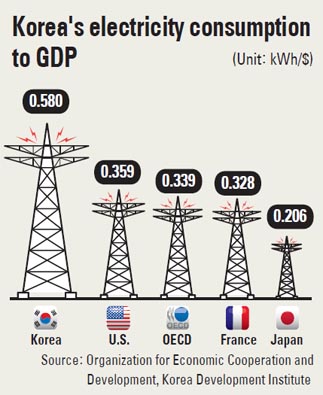Blackout threat looms large in tune with usage

“It is amazing that the blackout [on Thursday] took as long as it did to happen,” said Lee Soo-il, a researcher at the Korea Development Institute.
Lee has been involved with a project led by the Ministry of Knowledge Economy to find ways of upgrading the country’s electricity industry.
Electricity is supplanting other energy sources for people across the country, from skyscraper apartments in the capital to rural villages.
A 55-year-old farmer with the surname Lee who grows flowers in Gyeonggi is a classic example of this trend. He installed an electric heater in his greenhouses last year at a cost of 15 million won ($13,250).
“It is easy to adjust the temperature with electric heaters, and the electricity rate for farmers is very low,” he said.
“After four years, I will have covered the cost of buying the heater.”
In 2002, the government forecast that demand for electricity would peak in 2010 at 60.62 million kilowatts. As it turned out, the figure exceeded 71.30 million kilowatts.
This has eaten into this year’s reserves, bringing them down from the original target of 25 percent to 10 percent or less as supply fails to keep pace with demand.
According to the Ministry of Knowledge Economy, peak demand for electricity has increased 17.4 percent from 62.28 million kilowatts in 2007 to 73.13 million kilowatts this year. However, supply only climbed 13.3 percent from 67.19 million kilowatts to 76.13 million kilowatts.
“It is problematic that the rate at which electricity is being consumed is growing much faster than expected,” said Chun Yeong-hwan, a professor of electrical engineering at Hongik University.
“A similar blackout can easily occur in the next couple of years.”
As Korea continues to modernize, so electricity becomes ever-more ubiquitous.
Air-conditioning units are increasingly used to heat and cool schools and workplaces; gas and oil heaters are dumped in favor of electric heaters. And people do not prioritize energy-saving as the low cost makes it such an affordable commodity to waste.
As of 2009, the country’s rate of per-capita consumption stood at 8,833 kilowatts per hour, compared to 5,607 kilowatts in Britain, 7,512 kilowatts in France and 7,818 kilowatts in Japan.
But greater supply is not easily forthcoming. According to an electricity supply plan announced by the government last year, reserve to peak consumption is expected to remain below 10 percent until 2013.
When construction wraps up in 2014 on two nuclear reactors being built in South Gyeongsang, the reserve ratio will climb to 13.9 percent. Until then, the risk of another blackout looks destined to hang like a cloud over the country.
“Korea’s electricity reserve ratio has been falling since the early 2000s,” Lee said. “The recommended ratio is actually 15 percent to 18 percent.”
As the government has built up a track record of underestimating demand, it has habitually miscalculated the ratio and not prepared in advance by building more power plants, he added.
Another problem is that Korea has not kept pace with changing weather patterns.
“The government did not predict the changing weather pattern [this summer], which led to a power shortage and the blackout,” said Kim Chang-seop, a professor of energy at Kyungwon University.
“As last winter was extremely cold, demand for electricity has peaked twice in the last couple of years - once in the summer and again in the winter.”
Lee said estimates of demand need to be more generous. Others point the finger at public profligacy, citing the fact that electricity consumption rose on the day following the blackout as previous warnings seem to have fallen on deaf ears.
“The government has pushed down the price of electricity to escape some of the burden of inflationary pressure, but this has made it one of the cheapest energy sources,” said Jeong Han-gyeong, a researcher at the Korea Energy Economics Institute.
“Cheap electricity is encouraging overuse.”
By Cho Min-geun, Limb Jae-un [jbiz91@joongang.co.kr]
한글 관련 기사 [중앙일보]
유례없는 정전대란, 이래서 터졌다 ③ 수요 빠르게 느는데 공급은 늘 빠듯
[스페셜 리포트] “원가 못 미치는 전기요금이 수요 키워
실시간 요금제라도 서둘러 도입해야”
이수일 KDI 연구위원
“지금에야 대형 정전 사고가 터진 게 신기할 따름이다. 터질 게 터졌을 뿐이다.”
전국적인 정전 사고가 터진 다음 날인 16일 한국개발연구원(KDI) 이수일(사진) 연구위원은 이렇게 말했다. 전력의 수요와 공급 여건을 생각하면 위태위태한 상황이 계속 이어져 왔다는 것이다. 이 위원은 지난해 지식경제부의 전력산업 구조개편 용역을 담당했던 이 분야 전문가다.
그는 “우리나라의 전력 예비율이 2000년대 초반 이후 줄곧 하락 추세였다”고 했다. 고장 등을 감안한 공급 예비율은 2003년 17.1%에서 2011년 1월 5.5%까지 떨어졌다. 워낙 전력 수급이 빠듯하다 보니 수요예측을 조금만 잘못해도 이런 일이 발생할 위험이 점점 커져 왔던 것이다. 이 위원은 “설비 예비율은 15~18%가 적정 수준”이라고 말했다.
그렇다면 전력 예비율은 왜 계속 하락했을까.
우선 공급 측면에서 보면 장기적인 전력수요를 항상 과소추정하는 잘못을 저질렀다는 게 이 위원의 평가였다. 전력수급 기본계획이 정한 절차에 따라 장기 전력수요를 예측한 뒤 15~18%의 전력 예비율을 달성할 수 있는 선에서 발전소를 세우게 된다. 그런데 장기 전력수요를 과소추정하다 보니 발전설비를 충분히 건설하지 못했다는 것이다. 게다가 발전설비 측면에서 LNG복합발전에 참여 의사를 밝혔던 민간사업자들이 계획을 철회한 경우도 잦았다. 전력수급 기본계획에 따라 미리 정해놓은 발전설비가 필요한 만큼 건설되지 못했던 것이다. 이 위원은 “민간사업자의 약속 이행을 강제할 수단이 없다는 점이 문제였다”고 지적했다.
수요 측면도 문제였다. 원가에도 미치지 못하는 전기요금은 ‘시장원리’ 그대로 전력 수요를 키웠다. 이 위원은 “전력요금 현실화가 물가 등 거시경제 목표 때문에 당장 힘들다면 실시간 요금제라도 조속히 실시해야 한다”고 말했다. 실시간 요금제는 ‘똑똑한’ 계량기를 통해 전기 소비자에게 실제 전기를 생산하는 데 들어가는 요금(한계비용)을 알려주는 것이다. 전력 수요가 많지 않을 때는 발전단가가 싼 원전 전기를 쓰지만 전력 피크 때는 추가로 발전단가가 비싼 가스발전에서 나오는 전기가 들어간다. 생산비용이 비싸다면 그 정보를 가격에 반영해 전기 수요자가 가격에 반응해 수요를 줄일 수 있도록 해야 한다는 것이다.
이 위원은 “지금처럼 당장 누군가에게 정전사태의 책임을 묻는 데에만 신경 쓰면 정작 진짜 중요한 문제를 놓치게 된다”며 “중장기적인 시각에서 이번 사태의 정확한 배경과 원인을 짚어야 한다”고 조언했다.










with the Korea JoongAng Daily
To write comments, please log in to one of the accounts.
Standards Board Policy (0/250자)